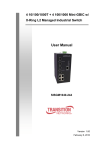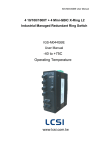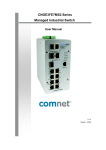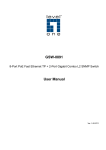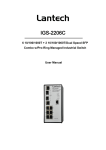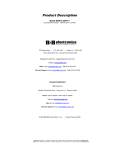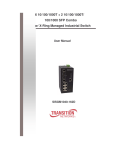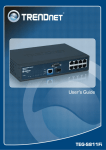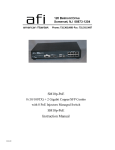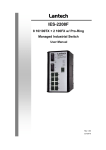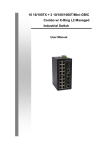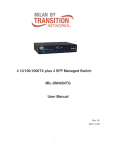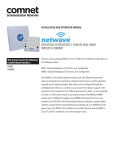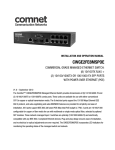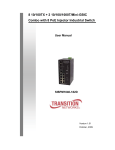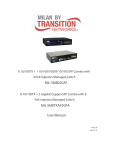Download ComNet™ CNGE8FX4TX4MS Managed Ethernet Switch
Transcript
INSTALLATION AND OPERATION MANUAL CNGE8FX4TX4MS ENVIRONMENTALLY HARDENED MANAGED ETHERNET SWITCH WITH (4) 10/100/1000TX + (4) 100/1000FX SFP PORTS V1.10 – July 2010 The ComNet™ CNGE8FX4TX4MS Managed Ethernet Switch provides transmission of (4) 100/1000 BASE-TX and (4) 10/100/1000FX combo ports. Unlike most Ethernet switches, these environmentally hardened units are designed for deployment in difficult operating environments, and are available for use with either conventional CAT-5e copper or optical transmission media. Ports 1 – 4 support the 10/100/1000 Mbps Ethernet IEEE 802.3 protocol, and auto-negotiating and auto-MDI/MDIX features are provided for simplicity and ease of installation. Ports 5 – 8 are 10/100/1000 configurable for copper or 100/1000 fiber media for use with multimode or single mode optical fiber without need for configuration, selected by optional SFP modules. These network managed layer 2 switches are optically and electrically compatible with any IEEE 802.3 compliant Ethernet devices. Plug-and-play design ensures ease of installation, and no electrical or optical adjustments are ever required. The CNGE8FX4TX4MS incorporates LED indicators for monitoring the operating status of the managed switch and network. Content Overview ............................................................................................................................... 1 Introduction...................................................................................................................................1 ComNet CNGE8FX4TX4MS Features...........................................................................................4 CNGE8FX4TX4MS Technical Specifications ................................................................................6 Packing List ..................................................................................................................................8 Safety Precaution..........................................................................................................................8 Hardware Description.......................................................................................................... 9 Front Panel....................................................................................................................................9 Top View .....................................................................................................................................10 Wiring the Power Inputs..............................................................................................................10 LED Indicators ............................................................................................................................12 Ports............................................................................................................................................13 Cabling........................................................................................................................................14 DIN-Rail Mounting Installation.......................................................................................... 17 Wall Mount Plate Mounting............................................................................................... 19 Hardware Installation ........................................................................................................ 20 Installation Steps ........................................................................................................................20 X-Ring Application ......................................................................................................................21 Coupling Ring Application ..........................................................................................................22 Dual Homing Application ............................................................................................................23 2 Console Management ....................................................................................................... 24 Connecting to the Console Port .................................................................................................24 Pin Assignment ...........................................................................................................................25 Login through the Console Interface ..........................................................................................26 CLI Management ........................................................................................................................28 System Commands Set.......................................................................................................................... 30 Port Commands Set ............................................................................................................................... 32 Trunk Commands Set ............................................................................................................................ 34 DMI Commands Set ............................................................................................................................... 36 VLAN Commands Set ............................................................................................................................ 36 Spanning Tree Commands Set .............................................................................................................. 38 QOS Commands Set.............................................................................................................................. 40 IGMP Commands Set ............................................................................................................................ 41 Mac / Filter Table Commands Set.......................................................................................................... 41 SNMP Commands Set ........................................................................................................................... 42 Port Mirroring Commands Set ............................................................................................................... 45 802.1x Commands Set........................................................................................................................... 45 TFTP Commands Set ............................................................................................................................. 47 SystemLog, SMTP and Event Commands Set ...................................................................................... 48 SNTP Commands Set ............................................................................................................................ 50 X-ring Commands Set ............................................................................................................................ 51 Web-Based Management.................................................................................................. 52 About Web-based Management.................................................................................................52 Preparing for Web Management.................................................................................................52 System Login ..............................................................................................................................53 Main interface .............................................................................................................................54 System Information.....................................................................................................................55 DHCP Server – System configuration.........................................................................................57 DHCP Client – System Configuration .........................................................................................58 DHCP Server - Port and IP Bindings ..........................................................................................58 TFTP – Firmware Update ............................................................................................................59 TFTP – Restore Configuration.....................................................................................................59 TFTP - Backup Configuration .....................................................................................................60 System Event Log – Syslog Configuration .................................................................................61 System Event Log - SMTP Configuration ...................................................................................62 System Event Log - Event Configuration....................................................................................63 Fault Relay Alarm ........................................................................................................................64 SNTP Configuration ....................................................................................................................65 IP Security...................................................................................................................................68 User Authentication ....................................................................................................................69 Port Statistics..............................................................................................................................70 Port Control.................................................................................................................................71 Port Trunk ...................................................................................................................................72 Aggregator setting.................................................................................................................................. 72 Aggregator Information .......................................................................................................................... 73 State Activity .......................................................................................................................................... 74 Port Mirroring ..............................................................................................................................75 Rate Limiting ...............................................................................................................................76 DMI (Digital Monitoring Interface) ...............................................................................................77 VLAN configuration .....................................................................................................................78 VLAN configuration - Port-based VLAN ................................................................................................. 79 802.1Q VLAN.......................................................................................................................................... 81 Rapid Spanning Tree ..................................................................................................................84 RSTP - System Configuration ................................................................................................................ 84 RSTP - Port Configuration...................................................................................................................... 85 SNMP Configuration ...................................................................................................................87 System Configuration ............................................................................................................................. 87 Trap Configuration.................................................................................................................................. 88 SNMPV3 Configuration .......................................................................................................................... 89 4 QoS Configuration ......................................................................................................................92 QoS Policy and Priority Type ................................................................................................................. 92 Port Base Priority ................................................................................................................................... 94 COS Configuration ................................................................................................................................. 94 TOS Configuration.................................................................................................................................. 94 IGMP Configuration ....................................................................................................................95 X-Ring .........................................................................................................................................97 LLDP Configuration.....................................................................................................................99 Security .....................................................................................................................................100 802.1X/Radius Configuration ............................................................................................................... 100 MAC Address Table ............................................................................................................................. 103 Factory Default..........................................................................................................................107 Save Configuration ...................................................................................................................107 System Reboot .........................................................................................................................107 Help ................................................................................................................................... 108 LED Diagnostic Indicators .............................................................................................. 108 Overview Introduction To create reliability in your network, the ComNet CNGE8FX4TX4MS 4 10/100/1000T + 4 SFP Managed Switch comes equipped with a proprietary redundant network protocol—X-Ring provides users with an easy way to establish a redundant Ethernet network with ultra high-speed recovery time less than 20ms. Also, the long MTBF (Mean Time Between Failures) ensures that the switch will continue to operate until a Gigabit network infrastructure has been established, without requiring any extra upgrade costs. Aside from 4 x 10/100/1000Base-T fast Ethernet ports, the CNGE8FX4TX4MS comes equipped with 4 SFP (mini-GBIC) ports. Traditional RJ45 ports can be used for uplinking wide-band paths in short distance (< 100 m), while the SFP slots can be used for the application of wideband uploading and long distance transmissions to fit the field request flexibility. Also, the long MTBF (Mean Time Between Failures) ensures that the CNGE8FX4TX4MS will continue to operate until a Gigabit network infrastructure has been established, without requiring any extra upgrade costs. SFP Advantages The SFP fiber slots provide a lot of flexibility when planning and implementing a network. The slot can accept any SFP-type fiber module and these modules are designed for transmitting over distances of either 550m (multi-mode), 10km, 30km, 50km, 70km or 110km (single-mode)—and the slot supports SFP modules for WDM single-fiber transmissions. This means that you can easily change the transmission mode and distance of the switch by simply pulling out the SFP module and plugging in a different module. The SFP modules are hot-swappable and plug-and-play. SFP with DMI (Digital Monitoring Interface) function The ComNet™ SFP supports a digital monitoring interface (DMI) function that allows real-time access to device operating parameters, and includes optional digital features such 1 as soft control and monitoring of SFP I/O signals. In addition, you can set up the action of alarms and warnings by ports to manage your devices. High-Speed Transmission The CNGE8FX4TX4MS includes a switch controller that can automatically sense transmission speeds (10/100/1000 Mbps). The RJ45 interface can also be auto-detected, so MDI or MDI-X is automatically selected and a crossover cable is not required. All Ethernet ports have memory buffers that support the store-and-forward mechanism. This assures that data is properly transmitted. Dual Power Input The redundant power input design of the CNGE8FX4TX4MS is with power reserve protection to prevent the switch from being damaged by using the wrong power source. When one of power input has failed, the P-Fail LED will turn on and send an alarm through a relay output to notify the user. Flexible Mounting The CNGE8FX4TX4MS is a compact size and can be mounted on a DIN-rail or panel. It can be used in any location where space is scarce. Advanced Protection The power line of the CNGE8FX4TX4MS supports up to 3,000 VDC EFT protection, which protects the switch from unregulated voltage and provides greater reliability. This high voltage protection feature protects all the ports and makes the CNGE8FX4TX4MS suitable for us in harsh industrial environments Wide Operating Temperature The ambient operating temperature of the CNGE8FX4TX4MS is between -40oC ~ 75oC. 2 Easy Troubleshooting LED indicators make troubleshooting quick and easy. Each 10/100/1000 Base-TX port has 2 LEDs that display the link status and transmission speed. The three power indicators: PWR1, PWR2 and P-Fail assist in diagnosing any problems quickly. 3 ComNet CNGE8FX4TX4MS Features Provides four 10/100/1000Base-T Mbps Ethernet ports Provides four SFP (mini-GBIC) port (supports 100/1000 Mbps Dual Mode) SFPs support DMI function Supports full/half duplex flow control Supports auto-negotiation Supports MDI/MDI-X auto-crossover Supports Packet Buffer up to 1Mb Supports MAC Address up to 8Kb Supports surge (EFT) protection 3,000 VDC Supports 6,000 VDC Ethernet ESD protection Power Supply Wide-range Redundant Power Design Reverse Power Polarity Protection Current Overload Protection Case/Installation IP-30 Protection DIN Rail and Wall Mount Design Spanning Tree Support IEEE802.1d Spanning Tree Support IEEE802.1w Rapid Spanning Tree VLAN Port Based VLAN Support 802.1 Q Tag VLAN GVRP X-Ring X-Ring, Dual Homing and Couple Ring Topology Provide redundant backup feature with a recovery time below 20ms Port Trunk with LACP QoS (Quality of Service) Support IEEE 802.1p Class of Service Per port provides 4 priority queues Port Base, Tag Base and Type of Service Priority 4 Bandwidth Control Ingress Packet Filter and Egress Rate Limit Broadcast/Multicast Packet Filter Control Port Mirror: Monitor traffic in switched networks. TX Packet only RX Packet only Both of TX and RX Packet System Event Log System Log Server/Client SMTP e-mail Alert Relay Alarm Output System Events Security Port Security: MAC address entries/filter IP Security: IP address security management to prevent unauthorized intruder Login Security: IEEE802.1X/RADIUS SNMP Trap Device cold start Power status Authentication failure X-Ring topology changed Port Link up/Link down IGMP with Query mode for Multi Media Application TFTP Firmware Update and System Configure Restore and Backup Ambient operating temperature range -40oC ~ 75oC 5 CNGE8FX4TX4MS Technical Specifications Communication Compatibility IEEE 802.3, 802.3u, 802.3ab IEEE 802.3x, 802.3z, 802.3ad IEEE 802.1d, 802.1p, 802.1Q, 802.1x IEEE 802.1ab LAN 10/100/1000Base-T, 1000Base-X Transmission Speed Up to 1000 Mbps Interface Connectors 4 x RJ45 (4-port 10/100/1000TX) 4 x 100/1000 SFP sockets 6-pin removable screw terminal (Power & Relay) LED Indicators Unit: Power1, Power2, P-Fail, R-Master Ethernet port: Link/Active, 1000M SFP: Link/Active Network Management Configuration Web browser, Telnet, Serial Console, Windows Utility, TFTP, SNMP v1/v2c/v3, Port Speed/Duplex Configuration VLAN IEEE 802.1Q, GVRP, Port-based, VLAN Redundancy X-Ring (Recovery time < 20ms), Dual Homing, Couple Ring, 802.1w/d RSTP/STP Security IP Access security, post security, DHCP Server, Port and IP Binding, 802.1X Port Access Control Traffic Control IGMP Snooping/Query for multicast group management Port Trunking, Static/802.3ad LACP Rate limit and storm control IEEE 802.1p QoS Cos/TOS/DSCP priority queuing IEEE 802.3x flow control 6 Diagnostics Port Mirroring, Real-time traffic statistic, MAC Address Table, SNTP, Syslog, E-Mail Alert, SNMP, Trap, RMON Power Power Consumption 13 Watts Power Input 2 x Unregulated +12 ~ 48 VDC Fault Output 1 Relay Output Mechanism Dimensions (WxHxD) 59.6 x 152 x 105 mm Enclosure IP-30, Metal shell with solid mounting kits Mounting DIN-Rail, Wall Mount Protection ESD (Ethernet) 6,000 VDC Surge (EFT for power) 3,000 VDC Reverse Power Protection Yes Current Overload Protection Yes Environment Operating Temperature Range -40oC ~ 75oC Operating Humidity Range 5% ~ 95% (non-condensing) Storage Temperature -40oC ~ 85oC Storage Humidity 5% ~ 95% (non-condensing) Certification Safety UL508, cUL EMC FCC Class A, CE EN61000-6-2 CE EN61000-6-4 CE EN61000-4-2 (ESD) CE EN61000-4-3 (RS) CE EN61000-4-4 (EFT) 7 CE EN61000-4-5 (Surge) CE EN61000-4-6 (CS) CE EN61000-4-8 (Magnetic Field) CE EN61000-4-11 (Voltage DIP) CE EN61000-3-2 (Harmonics Current) CE EN61000-3-3 (Voltage Fluctuation & Flickers) Free Fall IEC60068-2-32 Shock IEC60068-2-27 Vibration IEC60068-2-6 Packing List 1 x 4 10/100/1000T + 4 SFP Managed Switch 1 x RS232 Cable 1 x User Manual 2 x Wall Mounting Bracket and Screws Safety Precaution Attention: IF DC voltage is supplied by an external circuit, please use a protection device on the power supply input. 8 Hardware Description In this section, we will introduce the CNGE8FX4TX4MS’s hardware spec, port, cabling information, and wiring installation. Front Panel The Front Panel of the CNGE8FX4TX4MS is shown as follows: Front Panel of the CNGE8FX4TX4MS Managed Switch 9 Top View The top panel of the CNGE8FX4TX4MS is equipped with one terminal block connector for two DC power inputs. Top panel of the 4 10/100/1000T + 4 SFP Switch Wiring the Power Inputs Primary Secondary (Redundant) Voltage Input Power Input Insert the positive and negative wires into the V+ and V- contacts on the terminal block connector. 10 Tighten the wire-clamp screws to prevent the wires from loosening. Note The wire gauge for the terminal block should be in the range between 12~ 20 AWG. 11 LED Indicators There are LEDs that display the power status and network status and are located on the front panel of the CNGE8FX4TX4MS switch. Each has its own specific meaning as noted below. LED Color Description On R-Master Green PWR1 Green PWR2 Green Off The switch is the master of the X-ring group The switch is not the master of the X-ring group On Power input 1 is active Off Power input 1 is inactive On Power input 2 is active Off Power input 2 is inactive Power input 1 or 2 is inactive or port link On P-Fail Red configuration) Off Link/Active (P5 ~ P8) P1 ~ P4 (Upper LED) P1 ~ P4 (Lower LED) Green Green down (depends on Fault Relay Alarm Power input 1 and 2 are both functional, or no power inputs On SFP port is linking Blinking Transmitting or receiving data Off Not connected to network On Connected to network Blinking Data is being transmitted or received Off Not connected to network On Green Off Connected to network at speed of 1000Mbps Connected to network at speed of 10/100Mbps LED indicators of the CNGE8FX4TX4MS Switch 12 Ports RJ45 ports (Auto MDI/MDIX): The RJ45 ports are auto-sensing for 10Base-T, 100Base-TX or 1000Base-T device connections. Auto MDI/MDIX means that you can connect to another switch or workstation without changing straight through or crossover cabling. See figures below for straight-through and crossover cable schematic. RJ45 Pin Assignments Note Pin Number Assignment 1 Tx+ 2 Tx- 3 Rx+ 6 Rx- “+” and “-” signs represent the polarity of the wires that make up each wire pair. All ports on this managed switch support automatic MDI/MDI-X operation. You can use straight-through cables (See Figure below) for all network connections to PCs or servers, or to other switches or hubs. In a straight-through cable, pins 1, 2, 3, and 6, at one end of the cable, are connected straight through to pins 1, 2, 3 and 6 at the other end of the cable. The 10BASE-T/100BASE-TX/1000BASE-T MDI and MDI-X port pin outs are as presented below. Pin MDI-X Signal Name MDI Signal Name 1 Receive Data plus (RD+) Transmit Data plus (TD+) 2 Receive Data minus (RD-) Transmit Data minus (TD-) 3 Transmit Data plus (TD+) Receive Data plus (RD+) 6 Transmit Data minus (TD-) Receive Data minus (RD-) 13 Straight Through Cable Schematic Cross Over Cable Schematic Cabling Use the four twisted-pair, Category 5e or above cabling for all RJ45 port connections. The length of cable between the switch and the link partner (switch, hub, workstation, etc.) must be less than 100 meters (328 ft.) long. The small form-factor pluggable (SFP) devices that are the compact optical transceivers used for optical communication for both telecommunication and data communication applications. To connect the transceiver and LC cable, please follow the steps shown: 1. Insert the SFP device into the SFP receptacle. Notice that the triangle mark is the bottom of the module. SFP Receptacle 14 2. SFP Inserted Insert the fiber cable of LC connector into the SFP. LC connector to the SFP To remove the LC connector from the SFP, please follow the steps shown below: 1. Press the upper side of the LC connector from the SFP and pull it out to release. Remove LC connector 15 2. Push down the metal loop and pull the SFP out by the plastic part. Pull out from the SFP receptacle 16 DIN-Rail Mounting Installation The DIN-Rail mount is attached to the CNGE8FX4TX4MS at the factory. If the DIN-Rail is not attached to the switch, please see the following to attach the DIN-Rail to the switch. 1. 2. Insert the screws to attach the DIN-Rail to the switch. To remove the DIN-Rail, reverse step 1. 17 1. Insert the top of DIN-Rail into the track. 2. Lightly push the button of DIN-Rail mount into the track. 3. 4. Check the switch is held securely on the track. To remove the switch from the track, reverse the above steps. 18 Wall Mount Plate Mounting Follow the steps as below to mount the switch with the wall mount plate. 1. Remove the DIN-Rail from the switch; loosen the screws to remove the DIN-Rail mount. 2. Place the wall mount plate on the rear panel of the switch. 3. Use the screws to screw the wall mount plate on the switch. 4. Use the hook holes at the corners of the wall mount plate to hang the switch on the wall. 5. To remove the wall mount plate, reverse steps above. Use screws to screw the wall mount plate on the rear side 19 Hardware Installation This section describes how to install the CNGE8FX4TX4MS Switch and the installation steps. Installation Steps 1. 2. 3. 4. 5. 6. Note 7. 8. Unpack the switch from carton. Check the DIN-Rail is screwed on the Switch. If the DIN-Rail mount is not attached to the switch, please refer to DIN-Rail Mounting section for DIN-Rail mounting installation. If you want to wall mount the switch, then please refer to Wall Mount Plate Mounting section for wall mount plate installation. To hang the switch on the DIN-Rail track or wall, please refer to the Mounting Installation section. Power on the switch. To wire power for the switch, please refer to the Wiring the Power Inputs section. The power LED on the switch will illuminate. Please refer to the LED Indicators section for the meaning of the LED lights. Prepare the twisted-pair, straight-through Category 5e (or above) cable for the Ethernet connection and SFP transceiver for the fiber connection. Insert one side of Category 5e (or above) cables into the switch Ethernet port (RJ45 port) and the other side of Category 5e (or above) cables to the network device’s Ethernet port (RJ45 port), ex: switch, PC or Server. The UTP port (RJ45) LED on the switch will illuminate when the cable is connected to the network device. Please refer to the LED Indicators section for LED light meaning. Be sure the connected network devices support MDI/MDI-X. If it does not support, then use the crossover category 5e (or above) cable. For the SFP (mini-GBIC) port, please refer to the Cabling segment. When all connections are set and LED lights illuminate normal, the installation is complete. 20 X-Ring Application The switch supports the X-Ring protocol that can help the network recover from network connection failure within 20ms or less, and make the network system more reliable. The X-Ring algorithm is similar to Spanning Tree Protocol (STP) and Rapid STP (RSTP) algorithm but its recovery time is less than STP/RSTP. The figure below is a sample of X-Ring application. 21 Coupling Ring Application In the network, it may be necessary to have more than one X-Ring group. By using the coupling function it is possible to connect each X-Ring for a redundant backup. This will ensure the transmission between two ring groups will not fail. The following figure is an example of the coupling ring feature. 22 Dual Homing Application The Dual Homing function is designed to prevent a connection loss between the X-Ring group and an upper level/core switch. By assigning two ports on the switches as Dual Homing ports, they will become the designated backup ports in the X-Ring group. The Dual Homing function only works when the X-Ring function is made active. Each X-Ring group can only have one Dual Homing port. Note In Dual Homing application architecture, the upper level switches must enable Rapid Spanning Tree protocol. 23 Console Management Connecting to the Console Port The cable supplied with the switch has an RS232 connector on one end and the other end is an RJ45 connector. Attach the end of the RS232 connector to a PC or terminal and the other end of RJ45 connector to the console port of switch. The connected terminal or PC must support the terminal emulation program. 24 Pin Assignment DB9 RJ45 Connector Connector NC 1 Orange/White 2 2 Orange 3 3 Green/White NC 4 Blue 5 5 Blue/White NC 6 Green NC 7 Brown/White NC 8 Brown 25 Login through the Console Interface When the switch and PC are connected, turn on the PC and run a terminal emulation program or Hyper Terminal and configure the communication parameters to match the following default characteristics of the console port: Baud Rate: 9600 bps Data Bits: 8 Parity: none Stop Bit: 1 Flow control: None The settings of communication parameters After finishing the parameter settings, select ‘OK’. When the blank screen shows up, press Enter key to bring out the login prompt. Key in the ‘admin’ (default value) for the both User 26 name and Password (use Enter key to switch), then press Enter key and the Main Menu of console management appears. See below figure for login screen. Console login interface 27 CLI Management The system supports the console management – CLI command. After you login to the system, you will see a command prompt. To enter CLI management interface, type in ‘enable’ command. CLI command interface 28 Commands Level The following table lists the CLI commands and description. Modes Access Method Prompt Exit Method About This Mode1 The user commands available at the user level are a subset of those Begin a User EXEC session with switch> your switch. Enter logout or available at the privileged level. quit. Use this mode to • Perform basic tests. •Displays system information. Enter the Privileged EXEC The privileged command is enable command switch# while in user Enter disable to exit. EXEC mode. advance mode Privileged this mode to •Displays advance function status • Save configures Enter the To exit to configure Global command switch Configuration while in (config)# privileged privileged Use this mode to configure EXEC mode, parameters that apply to your enter exit or switch as a whole. end EXEC mode. Enter the vlan database VLAN command switch database while in (vlan)# privileged To exit to user EXEC mode, enter exit. Use this mode to configure VLAN-specific parameters. EXEC mode. Enter the To exit to interface of global fast Ethernet command Interface (with a configuration specific interface) while in global configuration mode configuration switch mode, enter Use this mode to configure (config-if) exit. parameters for the switch and # To exist to Ethernet ports. privileged EXEC mode, or end. 29 System Commands Set Command show config Level Description E Show switch Example switch>show config configuration show terminal P Show console switch#show terminal information write memory P Save user configuration switch#write memory into permanent memory (flash rom) system name G Configure system name switch(config)#system name xxx G Set switch system switch(config)#system location xxx [System Name] system location location string [System Location] system description G [System Description] system contact G switch(config)#system description description string xxx Set switch system switch(config)#system contact xxx contact window string [System Contact] show system-info Set switch system E Show system switch>show system-info information ip address G [Ip-address] Configure the IP switch(config)#ip address address of switch 192.168.10.1 255.255.255.0 [Subnet-mask] 192.168.10.254 [Gateway] ip dhcp G Enable DHCP client switch(config)#ip dhcp function of switch show ip P Show IP information of switch#show ip switch no ip dhcp G Disable DHCP client switch(config)#no ip dhcp function of switch switch(config)#reload G Halt and perform a cold restart Restore to default G Changes a login switch(config)#admin username username. xxxxxx reload G default admin username [Username] switch(config)#default (maximum 10 words) admin password [Password] G Specifies a password switch(config)#admin password (maximum 10 words) xxxxxx 30 show admin P Show administrator switch#show admin information dhcpserver enable G Enable DHCP Server switch(config)#dhcpserver enable Dhcpserver disable G Disable DHCP Server switch(config)#no dhcpserver dhcpserver lowip G Configure low IP switch(config)#dhcpserver lowip address for IP pool 192.168.1.100 Configure high IP switch(config)#dhcpserver highip address for IP pool 192.168.1.200 Configure subnet mask switch(config)#dhcpserver for DHCP clients subnetmask 255.255.255.0 Configure gateway for switch(config)#dhcpserver gateway DHCP clients 192.168.1.254 Configure DNS IP for switch(config)#dhcpserver dnsip DHCP clients 192.168.1.1 Configure lease time (in switch(config)#dhcpserver leasetime hour) 1 Set static IP for DHCP switch(config)#interface fastEthernet clients by port 2 [Low IP] dhcpserver highip G [High IP] dhcpserver subnetmask G [Subnet mask] dhcpserver gateway G [Gateway] dhcpserver dnsip G [DNS IP] dhcpserver leasetime G [Hours] dhcpserver ipbinding I [IP address] switch(config-if)#dhcpserver ipbinding 192.168.1.1 show dhcpserver P configuration show dhcpserver clients P Show configuration of switch#show dhcpserver DHCP server configuration Show client entries of switch#show dhcpserver clients DHCP server show dhcpserver P Show IP-Binding switch#show dhcpserver ip-binding information of DHCP ip-binding server no dhcpserver G Disable DHCP server switch(config)#no dhcpserver function security enable G Enable IP security switch(config)#security enable function security http G Enable IP security of switch(config)#security http HTTP server security telnet G Enable IP security of telnet server 31 switch(config)#security telnet security ip G Set the IP security list [Index(1..10)] [IP switch(config)#security ip 1 192.168.1.55 Address] show security P Show the information of switch#show security IP security no security G Disable IP security switch(config)#no security function no security http G Disable IP security of switch(config)#no security http HTTP server no security telnet G Disable IP security of switch(config)#no security telnet telnet server Port Commands Set Command interface fastEthernet Level G [Portid] duplex I [full | half] Description Example Choose the port for switch(config)#interface fastEthernet modification. 2 Use the duplex switch(config)#interface fastEthernet configuration command 2 to specify the duplex switch(config-if)#duplex full mode of operation for Fast Ethernet. speed I [10|100|1000|auto] Use the speed switch(config)#interface fastEthernet configuration command 2 to specify the speed switch(config-if)#speed 100 mode of operation for Fast Ethernet., the speed can’t be set to 1000 if the port isn’t a giga port. no flowcontrol I Disable flow control of switch(config-if)#no flowcontrol interface security enable I Enable security of switch(config)#interface fastEthernet interface 2 switch(config-if)#security enable 32 no security I Disable security of switch(config)#interface fastEthernet interface 2 switch(config-if)#no security Set interface ingress switch(config)#interface fastEthernet limit frame type to 2 ‘accept all frame’ switch(config-if)#bandwidth type all Set interface ingress switch(config)#interface fastEthernet broadcast-multicast-floo limit frame type to 2 ded-unicast ‘accept broadcast, switch(config-if)#bandwidth type multicast, and flooded broadcast-multicast-flooded-unicas unicast frame’ t Set interface ingress switch(config)#interface fastEthernet limit frame type to 2 ‘accept broadcast and switch(config-if)#bandwidth type multicast frame’ broadcast-multicast Set interface ingress switch(config)#interface fastEthernet limit frame type to ‘only 2 accept broadcast switch(config-if)#bandwidth type frame’ broadcast-only Set interface input switch(config)#interface fastEthernet bandwidth. Rate Range 2 is from 100 kbps to switch(config-if)#bandwidth in 100 bandwidth type all bandwidth type bandwidth type I I I broadcast-multicast bandwidth type I broadcast-only bandwidth in I [Value] 102400 kbps or to 256000 kbps for giga ports, and zero means no limit. bandwidth out Set interface output switch(config)#interface fastEthernet [Value] bandwidth. Rate Range 2 is from 100 kbps to switch(config-if)#bandwidth out 100 102400 kbps or to 256000 kbps for giga ports, and zero means no limit. show bandwidth I Show interfaces switch(config)#interface fastEthernet 33 bandwidth control 2 switch(config-if)#show bandwidth state I [Enable | Disable] Use the state interface switch(config)#interface fastEthernet configuration command 2 to specify the state switch(config-if)#state Disable mode of operation for Ethernet ports. Use the disable form of this command to disable the port. show interface I configuration show interface switch(config)#interface fastEthernet configuration status 2 switch(config-if)#show interface configuration show interface status I show interface actual switch(config)#interface fastEthernet status 2 switch(config-if)#show interface status show interface I accounting show interface statistic switch(config)#interface fastEthernet counter 2 switch(config-if)#show interface accounting no accounting I Clear interface switch(config)#interface fastEthernet accounting information 2 switch(config-if)#no accounting Trunk Commands Set Command aggregator priority Level G Example Set port group system switch(config)#aggregator priority 22 priority [1~65535] aggregator activityport Description G Set activity port switch(config)#aggregator [Group ID] activityport 2 [Port Numbers] aggregator group [GroupID] [Port-list] G Assign a trunk group switch(config)#aggregator group 1 with LACP active. 1-4 lacp workp 2 34 lacp [GroupID] :1~4 or workp [Port-list]:Member port switch(config)#aggregator group 2 [Workport] list, This parameter 1,4,3 lacp workp 3 could be a port range(ex.1-4) or a port list separate by a comma(ex.2, 3, 6) [Workport]: The amount of work ports, this value could not be less than zero or be large than the amount of member ports. Assign a static trunk switch(config)#aggregator group 1 [GroupID] [Port-list] group. 2-4 nolacp nolacp [GroupID] :1~4 or [Port-list]:Member port switch(config)#aggregator group 1 list, This parameter 3,1,2 nolacp aggregator group G could be a port range(ex.1-4) or a port list separate by a comma(ex.2, 3, 6) show aggregator P Show the information of switch#show aggregator 1 trunk group or switch#show aggregator 2 or switch#show aggregator 3 no aggregator lacp G switch(config)#no aggreator lacp 1 function of trunk group [GroupID] no aggregator group Disable the LACP G Remove a trunk group [GroupID] 35 switch(config)#no aggreator group 2 DMI Commands Set Command Level show dmi I Description Example Show DMI port status switch(config)#interface fastEthernet (Port 5 to port 8 5 supports DMI fuction) switch(config-if)#show dmi Description Example Enter VLAN configure switch#vlan database VLAN Commands Set Command vlan database Level P mode Vlanmode V [portbase| 802.1q | To set switch VLAN switch(vlan)#vlanmode portbase mode. or switch(vlan)#vlanmode 802.1q gvrp] or switch(vlan)#vlanmode gvrp no vlan V No VLAN Switch(vlan)#no vlan Add new port based switch(vlan)#vlan port-based VALN grpname test grpid 2 port 2-4 Ported based VLAN configuration vlan port-based V grpname [Group Name] or grpid switch(vlan)#vlan port-based [GroupID] grpname test grpid 2 port 2,3,4 port [PortNumbers] show vlan [GroupID] or show vlan no vlan group [GroupID] V Show VLAN information switch(vlan)#show vlan 23 V Delete port base group switch(vlan)#no vlan group 2 ID IEEE 802.1Q VLAN vlan 8021q name [GroupName] vid [VID] V Change the name of switch(vlan)#vlan 8021q name test VLAN group, if the vid 22 group didn’t exist, this command can’t be applied. vlan 8021q port [PortNumber] access-link untag [UntaggedVID] V Assign a access link for switch(vlan)#vlan 8021q port 3 VLAN by port, if the port access-link untag 33 36 belong to a trunk group, this command can’t be applied. vlan 8021q port [PortNumber] trunk-link tag [TaggedVID List] vlan 8021q port [PortNumber] hybrid-link untag [UntaggedVID] tag [TaggedVID List] vlan 8021q trunk [PortNumber] access-link untag [UntaggedVID] vlan 8021q trunk [PortNumber] trunk-link tag V V V V Assign a trunk link for switch(vlan)#vlan 8021q port 3 VLAN by port, if the port trunk-link tag 2,3,6,99 belong to a trunk group, or this command can’t be switch(vlan)#vlan 8021q port 3 applied. trunk-link tag 3-20 Assign a hybrid link for switch(vlan)#vlan 8021q port 3 VLAN by port, if the port hybrid-link untag 4 tag 3,6,8 belong to a trunk group, or this command can’t be switch(vlan)#vlan 8021q port 3 applied. hybrid-link untag 5 tag 6-8 Assign a access link for switch(vlan)#vlan 8021q trunk 3 VLAN by trunk group access-link untag 33 Assign a trunk link for switch(vlan)#vlan 8021q trunk 3 VLAN by trunk group trunk-link tag 2,3,6,99 or [TaggedVID List] switch(vlan)#vlan 8021q trunk 3 trunk-link tag 3-20 vlan 8021q trunk [PortNumber] hybrid-link untag [UntaggedVID] tag [TaggedVID List] V Assign a hybrid link for switch(vlan)#vlan 8021q trunk 3 VLAN by trunk group hybrid-link untag 4 tag 3,6,8 or switch(vlan)#vlan 8021q trunk 3 hybrid-link untag 5 tag 6-8 show vlan [GroupID] or show vlan no vlan group [GroupID] V Show VLAN information switch(vlan)#show vlan 23 V Delete port base group switch(vlan)#no vlan group 2 ID 37 Spanning Tree Commands Set Command Level Description Example spanning-tree enable G Enable spanning tree switch(config)#spanning-tree enable spanning-tree priority G Configure spanning tree switch(config)#spanning-tree priority priority parameter 32767 Use the spanning-tree switch(config)#spanning-tree max-age global max-age 15 [0~61440] spanning-tree max-age G [seconds] configuration command to change the interval between messages the spanning tree receives from the root switch. If a switch does not receive a bridge protocol data unit (BPDU) message from the root switch within this interval, it recomputed the Spanning Tree Protocol (STP) topology. spanning-tree G hello-time [seconds] Use the spanning-tree switch(config)#spanning-tree hello-time global hello-time 3 configuration command to specify the interval between hello bridge protocol data units (BPDUs). spanning-tree forward-time [seconds] G Use the spanning-tree switch(config)#spanning-tree forward-time global forward-time 20 configuration command to set the forwarding-time for the specified spanning-tree instances. The forwarding time determines how long 38 each of the listening and stp-path-cost I [1~200000000] learning states last before the port begins forwarding. Use the spanning-tree switch(config)#interface fastEthernet cost interface 2 configuration command switch(config-if)#stp-path-cost 20 to set the path cost for Spanning Tree Protocol (STP) calculations. In the event of a loop, spanning tree considers the path cost when selecting an interface to place into the forwarding state. stp-path-priority I [Port Priority] Use the spanning-tree switch(config)#interface fastEthernet port-priority interface 2 configuration command switch(config-if)#stp-path-priority to configure a port 128 priority that is used when two switches tie for position as the root switch. stp-admin-p2p I [Auto|True|False] Admin P2P of STP switch(config)#interface fastEthernet priority on this interface. 2 switch(config-if)#stp-admin-p2p Auto stp-admin-edge [True|False] I Admin Edge of STP switch(config)#interface fastEthernet priority on this interface. 2 switch(config-if)#stp-admin-edge True 39 stp-admin-non-stp I [True|False] Admin NonSTP of STP switch(config)#interface fastEthernet priority on this interface. 2 switch(config-if)#stp-admin-non-stp False show spanning-tree E Displays a summary of switch>show spanning-tree the spanning-tree states. no spanning-tree G Disable spanning-tree. switch(config)#no spanning-tree Description Example Select QOS policy switch(config)#qos policy scheduling weighted-fair Setting of QOS priority switch(config)#qos prioritytype QOS Commands Set Command Level qos policy G [weighted-fair|strict] qos prioritytype G type [port-based|cos-only|tos -only|cos-first|tos-first] qos priority portbased [Port] [lowest|low|middle|high] qos priority cos [Priority][lowest|low|mid dle|high] qos priority tos G G Configure Port-based switch(config)#qos priority portbased Priority 1 low Configure COS Priority switch(config)#qos priority cos 0 middle G Configure TOS Priority switch(config)#qos priority tos 3 high P Displays the information Switch#show qos [Priority][lowest|low|mid dle|high] show qos of QoS configuration no qos G Disable QoS function 40 switch(config)#no qos IGMP Commands Set Command igmp enable Level G Description Example Enable IGMP snooping switch(config)#igmp enable function igmp query auto G Set IGMP query to auto switch(config)#igmp query auto mode igmp query force G Set IGMP query to force switch(config)#igmp query force mode Show igmp P switch#show igmp configuration an IGMP configuration. configuration Show igmp multi Displays the details of P Displays the details of switch#show igmp multi an IGMP snooping entries. no igmp G Disable IGMP snooping switch(config)#no igmp function no igmp query G Disable IGMP query switch#no igmp query Mac / Filter Table Commands Set Command Description Example Configure MAC address switch(config)#interface fastEthernet static hwaddr table of interface 2 [MAC] (static). switch(config-if)#mac-address-table mac-address-table Level I static hwaddr 000012345678 mac-address-table filter G hwaddr Configure MAC address switch(config)#mac-address-table table(filter) filter hwaddr 000012348678 Show all MAC address switch#show mac-address-table [MAC] show P table mac-address-table show P mac-address-table Show static MAC switch#show mac-address-table address table static Show filter MAC switch#show mac-address-table address table. filter Remove an entry of switch(config)#interface fastEthernet MAC address table of 2 static show P mac-address-table filter no mac-address-table static hwaddr I 41 interface (static) [MAC] switch(config-if)#no mac-address-table static hwaddr 000012345678 Remove an entry of switch(config)#no mac-address-table filter hwaddr MAC address table filter hwaddr 000012348678 [MAC] (filter) no mac-address-table no mac-address-table G G Remove dynamic entry switch(config)#no mac-address-table of MAC address table SNMP Commands Set Command Description Example Set SNMP agent switch(config)#snmp system-name system name l2switch Set SNMP agent switch(config)#snmp system-location system location lab Set SNMP agent switch(config)#snmp system-contact system contact where Select the agent mode switch(config)#snmp agent-mode of SNMP v1v2cv3 Add SNMP community switch(config)#snmp string. community-strings public right rw Configure SNMP server switch(config)#snmp-server host [IP address] host information and 192.168.1.50 community public community community string trap-version v1 snmp system-name Level G [System Name] snmp system-location G [System Location] snmp system-contact G [System Contact] snmp agent-mode G [v1v2c|v3|v1v2cv3] snmp G community-strings [Community] right [RO/RW] snmp-server host G [Community-string] (remove) trap-version Switch(config)# [v1|v2c] no snmp-server host 192.168.1.50 snmpv3 context-name [Context Name ] G Configure the context switch(config)#snmpv3 context-name name Test 42 Configure the switch(config)#snmpv3 user test01 [User Name] userprofile for SNMPV3 group G1 password AuthPW PrivPW group agent. Privacy [Group Name] password could be password empty. snmpv3 user G [Authentication Password] [Privacy Password] snmpv3 access G context-name [Context Configure the access switch(config)#snmpv3 access table of SNMPV3 agent context-name Test group G1 Name ] security-level AuthPriv group match-rule Exact views V1 V1 V1 [Group Name ] security-level [NoAuthNoPriv|AuthNoP riv|AuthPriv] match-rule [Exact|Prifix] views [Read View Name] [Write View Name] [Notify View Name] snmpv3 mibview view G [View Name] Configure the mibview switch(config)#snmpv3 mibview view table of SNMPV3 agent V1 type Excluded sub-oid 1.3.6.1 Show SNMP switch#show snmp type [Excluded|Included] sub-oid [OID] show snmp P configuration no snmp G community-strings Remove the specified switch(config)#no snmp community. community-strings public Remove the SNMP switch(config)#no snmp-server server host. 192.168.1.50 Remove specified user switch(config)#no snmpv3 user Test [Community] no snmp-server host G [Host-address] no snmpv3 user G 43 of SNMPv3 agent. [User Name] Remove specified switch(config)#no snmpv3 access context-name [Context access table of context-name Test group G1 Name ] SNMPv3 agent. security-level AuthPr no snmpv3 access G group iv match-rule Exact views V1 V1 V1 [Group Name ] security-level [NoAuthNoPriv|AuthNoP riv|AuthPriv] match-rule [Exact|Prifix] views [Read View Name] [Write View Name] [Notify View Name] Remove specified switch(config)#no snmpv3 mibview [View Name] mibview table of view V1 type Excluded sub-oid type SNMPV3 agent. 1.3.6.1 no snmpv3 mibview view G [Excluded|Included] sub-oid [OID] 44 Port Mirroring Commands Set Command Level monitor rx G Description Example Set RX destination port switch(config)#monitor rx of monitor function monitor tx G Set TX destination port switch(config)#monitor tx of monitor function show monitor P Show port monitor switch#show monitor information monitor I [RX|TX|Both] Configure source port switch(config)#interface fastEthernet of monitor function 2 switch(config-if)#monitor RX show monitor I Show port monitor switch(config)#interface fastEthernet information 2 switch(config-if)#show monitor no monitor I Disable source port of switch(config)#interface fastEthernet monitor function 2 switch(config-if)#no monitor 802.1x Commands Set Command 8021x enable Level G Description Example Use the 802.1x global switch(config)# 8021x enable configuration command to enable 802.1x protocols. 8021x system radiusip G [IP address] Use the 802.1x system switch(config)# 8021x system radius IP global radiusip 192.168.1.1 configuration command to change the radius server IP. 8021x system serverport G [port ID] Use the 802.1x system switch(config)# 8021x system server port global serverport 1815 configuration command to change the radius server port 8021x system G Use the 802.1x system 45 switch(config)# 8021x system accountport account port global [port ID] configuration command accountport 1816 to change the accounting port 8021x system sharekey G [ID] Use the 802.1x system switch(config)# 8021x system share key global sharekey 123456 configuration command to change the shared key value. 8021x system nasid G [words] Use the 802.1x system switch(config)# 8021x system nasid nasid global test1 configuration command to change the NAS ID 8021x misc quietperiod G [sec.] Use the 802.1x misc switch(config)# 8021x misc quiet period global quietperiod 10 configuration command to specify the quiet period value of the switch. 8021x misc txperiod G Use the 802.1x misc TX switch(config)# 8021x misc txperiod 5 period global [sec.] configuration command to set the TX period. 8021x misc G supportimeout [sec.] Use the 802.1x misc switch(config)# 8021x misc supp timeout global supportimeout 20 configuration command to set the supplicant timeout. 8021x misc servertimeout G [sec.] Use the 802.1x misc switch(config)#8021x misc server timeout global servertimeout 20 configuration command to set the server timeout. 46 8021x misc maxrequest G [number] Use the 802.1x misc switch(config)# 8021x misc max request global maxrequest 3 configuration command to set the MAX requests. 8021x misc G reauthperiod [sec.] Use the 802.1x misc switch(config)# 8021x misc reauth period global reauthperiod 3000 configuration command to set the reauth period. Use the 802.1x port switch(config)#interface fastethernet [disable | reject | accept | state interface 3 authorize] configuration command switch(config-if)#8021x portstate to set the state of the accept 8021x portstate I selected port. show 8021x E Displays a summary of switch>show 8021x the 802.1x properties and also the port sates. no 8021x G Disable 802.1x function switch(config)#no 8021x TFTP Commands Set Command backup Level G flash:backup_cfg Description Defaults Example Save configuration to switch(config)#backup TFTP and need to specify flash:backup_cfg the IP of TFTP server and the file name of image. restore flash:restore_cfg G Get configuration from switch(config)#restore TFTP server and need to flash:restore_cfg specify the IP of TFTP server and the file name of image. upgrade flash:upgrade_fw G Upgrade firmware by TFTP switch(config)#upgrade and need to specify the IP flash:upgrade_fw of TFTP server and the file name of image. 47 SystemLog, SMTP and Event Commands Set Command Description Example Set System log server switch(config)# systemlog ip IP address. 192.168.1.100 G Specified the log mode switch(config)# systemlog mode both show systemlog E Displays system log. Switch>show systemlog show systemlog P Show system log client switch#show systemlog systemlog ip Level G [IP address] systemlog mode [client|server|both] & server information no systemlog G Disable systemlog switch(config)#no systemlog functon smtp enable G Enable SMTP function switch(config)#smtp enable smtp serverip G Configure SMTP server switch(config)#smtp serverip IP 192.168.1.5 Enable SMTP switch(config)#smtp authentication [IP address] smtp authentication G authentication smtp account G switch(config)#smtp account User authentication account [account] smtp password Configure G Configure switch(config)#smtp password authentication [password] password smtp rcptemail G [Index] [Email address] show smtp P Configure Rcpt e-mail switch(config)#smtp rcptemail 1 Address [email protected] Show the information of switch#show smtp SMTP no smtp G Disable SMTP function switch(config)#no smtp event device-cold-start G Set cold start event switch(config)#event type device-cold-start both Set Authentication switch(config)#event failure event type authentication-failure both Set X-ring topology switch(config)#event changed event type ring-topology-change both [Systemlog|SMTP|Both] event G authentication-failure [Systemlog|SMTP|Both] event ring-topology-change G [Systemlog|SMTP|Both] 48 event systemlog I [Link-UP|Link-Down|Bot Set port event for switch(config)#interface fastethernet system log 3 h] switch(config-if)#event systemlog both event smtp I Set port event for SMTP switch(config)#interface fastethernet [Link-UP|Link-Down|Bot 3 h] switch(config-if)#event smtp both show event P Show event selection switch#show event no event G Disable cold start event switch(config)#no event type device-cold-start Disable Authentication switch(config)#no event failure event typ authentication-failure Disable X-ring topology switch(config)#no event changed event type X-ring-topology-change Disable port event for switch(config)#interface fastethernet system log 3 device-cold-start no event G authentication-failure no event G X-ring-topology-change no event systemlog I switch(config-if)#no event systemlog no event smpt I Disable port event for switch(config)#interface fastethernet SMTP 3 switch(config-if)#no event smtp show systemlog P Show system log client & server information 49 switch#show systemlog SNTP Commands Set Command Level Description Example sntp enable G Enable SNTP function switch(config)#sntp enable sntp daylight G Enable daylight saving switch(config)#sntp daylight time, if SNTP function is inactive, this command can’t be applied. sntp daylight-period G [Start time] [End time] Set period of daylight switch(config)# sntp daylight-period saving time, if SNTP 20060101-01:01 20060202-01-01 function is inactive, this command can’t be applied. Parameter format: [yyyymmdd-hh:mm] sntp daylight-offset G Set offset of daylight switch(config)#sntp daylight-offset 3 saving time, if SNTP [Minute] function is inactive, this command can’t be applied. sntp ip G Set SNTP server IP, if switch(config)#sntp ip 192.169.1.1 SNTP function is [IP] inactive, this command can’t be applied. sntp timezone G Set timezone index, use switch(config)#sntp timezone 22 ‘show sntp timzezone’ [Timezone] command to get more information of index number show sntp P Show SNTP information switch#show sntp show sntp timezone P Show index number of switch#show sntp timezone time zone list no sntp G Disable SNTP function switch(config)#no sntp no sntp daylight G Disable daylight saving switch(config)#no sntp daylight time 50 X-ring Commands Set Command Leve l Description Example ring enable G Enable X-ring switch(config)#ring enable ring master G Enable ring master switch(config)#ring master ring couplering G Enable couple ring switch(config)#ring couplering ring dualhoming G Enable dual homing switch(config)#ring dualhoming ring ringport G Configure 1st/2nd Ring switch(config)#ring ringport 7 8 Port [1st Ring Port] [2nd Ring Port] ring couplingport G Configure Coupling Port switch(config)#ring couplingport 1 G Configure Control Port switch(config)#ring controlport 2 G Configure Dual Homing switch(config)#ring homingport 3 [Coupling Port] ring controlport [Control Port] ring homingport Port [Dual Homing Port] show ring P Show the information of switch#show ring X - Ring no ring G Disable X-ring switch(config)#no ring no ring master G Disable ring master switch(config)# no ring master no ring couplering G Disable couple ring switch(config)# no ring couplering no ring dualhoming G Disable dual homing switch(config)# no ring dualhoming 51 Web-Based Management About Web-based Management On CPU board of the switch there is an embedded HTML web site residing in the flash memory. This Graphic User Interface (GUI) offers advanced management features and allows users to manage the switch from anywhere on the network through a standard browser such as Microsoft Internet Explorer. The Web-Based Management supports Internet Explorer 6.0 or later version. It is applied for Java Applets to reducing the network bandwidth requirement while enhancing access speed and presenting an easy viewing screen. Preparing for Web Management Before using the web-based management interface, install the switch on the network and make sure that any one of the PCs on the network can connect with the switch through the web browser. The switch’s default IP address, subnet mask, username and password is shown below: IP Address: 192.168.10.1 Subnet Mask: 255.255.255.0 Default Gateway: 192.168.10.254 User Name: admin Password: admin 52 System Login 1. Launch Internet Explorer on the PC 2. Enter ‘http:// and the default IP address in the browser address bar. Press Enter or Return. 3. The login screen will appear. 4. Enter the user name and password. The default user name and password are the same: admin 5. Press Enter or OK, and then the home screen of the Web-based management appears as shown below: Login screen 53 Main interface Main interface 54 System Information Assigning the system name, location and viewing the system information System Name: Assign the name of switch. The maximum length is 64 bytes System Description: Displays the description of switch. This is Read only and cannot be modified System Location: Assign the switch physical location. The maximum length is 64 bytes System Contact: Enter the name of contact person or organization Firmware Version: Displays the switch’s firmware version Kernel Version: Displays the kernel software version MAC Address: Displays the unique hardware address assigned by manufacturer (default) System information interface 55 IP Configuration To configure the IP Settings and DHCP client function DHCP Client: When DHCP client function is enabled, the switch will be assigned an IP address from the network DHCP server. The default IP address will be replaced by the DHCP server assigned IP address. After the user selects Apply button, a popup dialog box appears. This is to inform the user that when the DHCP client is enabled, the current IP will be lost and the user should find the new IP address on the DHCP server. IP Address: Assigning the IP address that the network is using. If the DHCP client function is enabled, and the user does not need to assign an IP address, the network DHCP server will assign the IP address for the switch and display it in this column. The default IP address is 192.168.10.1. Subnet Mask: Assigning the subnet mask of the IP address. If DHCP client function is enabled, the user does not need to assign the subnet mask. Gateway: Assigning the network gateway for the switch. The default gateway is 192.168.10.254. DNS1: Assign the primary DNS IP address. DNS2: Assign the secondary DNS IP address. And then, select IP configuration interface 56 DHCP Server – System configuration The system provides the DHCP server function to enable the DHCP server function, the switch system will be a DHCP server. DHCP Server: Enable – the switch will become the DHCP server on your local network. Low IP Address: Low IP address is the beginning of the dynamic IP assignment range. For example: dynamic IP assignment range is from 192.168.10.100 ~ 192.168.10.200. In contrast, 192.168.10.100 is the Low IP address. High IP Address: High IP address is the end of the dynamic IP assignment range. For example: dynamic IP assignment range is from 192.168.10.100 ~ 192.168.10.200. In comparison, 192.168.10.200 is the High IP address. Subnet Mask: the dynamic IP assignment range subnet mask. Gateway: the gateway in your network. DNS: Domain Name Server IP Address in your network. Lease Time (sec): It is the time period that system will reset the dynamic IP assignment to ensure the dynamic IP will not been occupied for a long period of time or the server does not know that the dynamic IP is idle. And then, select DHCP Server Configuration interface 57 DHCP Client – System Configuration When the DHCP server function is active, the system will collect the DHCP client information and display it here. DHCP Client Entries interface DHCP Server - Port and IP Bindings You can assign the specific IP address that is the IP address in dynamic IP address assignment range to the specific port. When the device is connected to the port and requests dynamic IP address assignment, the system will assign the IP address that has been assigned previously to the connected device. Port and IP Bindings interface 58 TFTP – Firmware Update It provides the functions to allow a user to update the switch’s firmware. Before updating, make sure you have your TFTP server ready and the firmware image is on the TFTP server. 1. TFTP Server IP Address: fill in your TFTP server IP. 2. Firmware File Name: the name of firmware file. 3. Select . Update Firmware interface TFTP – Restore Configuration You can restore EEPROM value from TFTP server, but you must put the file on the TFTP server first, the switch will download back the flash image. 1. TFTP Server IP Address: Enter the TFTP server IP address. 2. Restore File Name: fill in the correct restore file name. 3. Select . Restore Configuration interface 59 TFTP - Backup Configuration You can save current EEPROM value from the switch to the TFTP server. You can then go to the TFTP restore configuration page to restore the EEPROM value. 1. TFTP Server IP Address: Enter the TFTP server IP address 2. Backup File Name: Enter the file name 3. Select . Backup Configuration interface 60 System Event Log – Syslog Configuration Configuring the system event mode that can be collected and the system log server IP address. 1. Syslog Client Mode: select the system log mode – client only, server only, or both client and server. 2. System Log Server IP Address: assigns the system log server IP address. 3. Select to refresh the events log. 4. Select to clear all current events log. 5. After configuring, select . Syslog Configuration interface 61 System Event Log - SMTP Configuration You can set up the mail server IP address, Email address accounts, account passwords, and forwarded Email accounts for receiving the event alert. 1. Email Alert: enable or disable the Email alert function. 2. SMTP Server IP: set up the mail server IP address (when Email Alert is enabled, this function will then be available). 3. Sender: Enter in a complete Email address, e.g. [email protected], to identify where the event log comes from. 4. Authentication: Select the check box to enable and configure the Email account and password needed for authentication (when Email Alert enabled, this function will then be available). 5. Mail Account: set up the Email account, e.g. [email protected], to receive the alert. It must be an existing Email account on the mail server, which had been set up in SMTP Server IP Address column. 6. Password: The Email account’s required password. 7. Confirm Password: reconfirm the password. 8. Recipient Email Addresses 1 ~ 6: you can assign up to 6 Email accounts also to receive the alert. 9. Select . SMTP Configuration interface 62 System Event Log - Event Configuration You can select the system log events and SMTP events. When selected events occur, the system will send out the event log information. Also, event per port log and SMTP events can be selected. After configure, select . System event selection: Four selections – 1) Device cold start, 2) Device warm start, 3) SNMP Authentication Failure, and 4) Topology change. Mark the checkbox to select the events to be monitored. When selected events occur, the system will log the event(s). Device cold start: when the device executes cold start action, the system will note a log event. Authentication Failure: when the SMTP authentication fails, the system will note a log event. X-ring topology change: when the X-ring topology has changed, the system will note a log event. Event Configuration interface 63 Port event selection: select the per port events and per port SMTP events. It has three selections – 1) Link UP, 2) Link Down, and 3) Link UP & Link Down. Disable means no event is selected. Link UP: the system will issue a log message when port connection is up only. Link Down: the system will issue a log message when port connection is down only. Link UP & Link Down: the system will issue a log message when port connection is up and down. Fault Relay Alarm Power Failure: Select the check box to enable the function of lighting up FAULT LED on the panel in the event of a power failure. Port Link Down/Broken: Mark the check box to enable the function of lighting up FAULT LED on the panel when Ports’ state reflect link down or link broken. Fault Relay Alarm interface 64 SNTP Configuration You can configure the SNTP (Simple Network Time Protocol) settings. The SNTP allows you to synchronize the switch’s clocks through the internet website. 1. SNTP Client: enable or disable SNTP function to get the time from the SNTP server. 2. Daylight Saving Time: enable or disable daylight savings time function. When daylight saving time is enabling, you need to configure the daylight saving time period. 3. UTC Timezone: set the switch location time zone. The table on the following page lists the different location time zone for your reference. 65 Local Time Zone Conversion from UTC Time at 12:00 UTC November Time Zone - 1 hour 11am Oscar Time Zone -2 hours 10 am ADT - Atlantic Daylight -3 hours 9 am -4 hours 8 am -5 hours 7 am -6 hours 6 am -7 hours 5 am -8 hours 4 am ALA - Alaskan Standard -9 hours 3 am HAW - Hawaiian Standard -10 hours 2 am Nome, Alaska -11 hours 1 am +1 hour 1 pm EET - Eastern European, USSR Zone 1 +2 hours 2 pm BT - Baghdad, USSR Zone 2 +3 hours 3 pm ZP4 - USSR Zone 3 +4 hours 4 pm ZP5 - USSR Zone 4 +5 hours 5 pm ZP6 - USSR Zone 5 +6 hours 6 pm WAST - West Australian Standard +7 hours 7 pm CCT - China Coast, USSR Zone 7 +8 hours 8 pm JST - Japan Standard, USSR Zone 8 +9 hours 9 pm +10 hours 10 pm +12 hours Midnight AST - Atlantic Standard EDT - Eastern Daylight EST - Eastern Standard CDT - Central Daylight CST - Central Standard MDT - Mountain Daylight MST - Mountain Standard PDT - Pacific Daylight PST - Pacific Standard ADT - Alaskan Daylight CET - Central European FWT - French Winter MET - Middle European MEWT - Middle European Winter SWT - Swedish Winter EAST - East Australian Standard GST Guam Standard, USSR Zone 9 IDLE - International Date Line NZST - New Zealand Standard NZT - New Zealand 66 4. SNTP Server URL: set the SNTP server IP address. 5. Daylight Saving Period: set up the Daylight Saving beginning date and Daylight Savings ending date. Both will be different in every year. 6. Daylight Savings Offset (mins): set the offset time. 7. Switch Timer: Displays the current switch time. 8. Select . SNTP Configuration interface 67 IP Security The IP security function allows user to assign 10 specific IP addresses that have permission to access the switch through the web browser for the securing switch management. IP Security Mode: when this option is in the Enable mode, the Enable HTTP Server and Enable Telnet Server check boxes will then be available. Enable HTTP Server: when this check box is checked, the IP addresses among Security IP1 ~ IP10 will be allowed access via HTTP service. Enable Telnet Server: when checked, the IP addresses among Security IP1 ~ IP10 will be allowed to access via telnet service. Security IP 1 ~ 10: Assign up to 10 specific IP address. Only these 10 IP address can access and manage the switch through the Web browser And then, select Note button to apply the configuration Remember to execute the ‘Save Configuration’ action, otherwise the new configuration will be lost when switch is powered off IP Security interface 68 User Authentication Change the default web management login user name and password for security management. 1. User name: Enter the new user name (The default is admin) 2. Password: Enter the new password (The default is admin) 3. Confirm password: Re-type the new password 4. And then, select User Authentication interface 69 Port Statistics The following information provides current port information statistics. Port: The port number. Type: Displays the current connection speed of the port. Link: The linkstatus — port is ‘Up’ or ‘Down’. State: Set by Port Control. When the state is disabled, the port will not transmit or receive any packet. Tx (Transmit) Good Packet: The counts of transmitting good packets via this port. Tx (Transmit) Bad Packet: The counts of transmitting bad packets (including undersize [less than 64 octets], oversize, CRC Align errors, fragments and jabbers packets) via this port. Rx (Receive) Good Packet: The counts of receiving good packets via this port. Rx (Receive) Bad Packet: The counts of receiving good packets (including undersize [less than 64 octets], oversize, CRC error, fragments and jabbers) via this port. Tx (Transmit) Abort Packet: The aborted packets lost while transmitting. Packet Collision: The counts of packets lost through collision. Packet Dropped: The counts of packets lost when dropped. Rx (Receive) Bcast (Broadcast) Packet: The counts of broadcast packets. Rx (Receive) Mcast (Multicast) Packet: The counts of multicast packets. Select button to clear all counts. Port Statistics interface 70 Port Control In Port Control, you can view the status of every port status that depends on the user setting and the negotiation result. 1. Port: select the port that you want to configure. 2. State: Current port status. The port can be set to disable or enable mode. If the port setting is disabled then it will not receive or transmit any packet. 3. Negotiation: set auto negotiation status of the port. 4. Speed: set the link speed of the port. 5. Duplex: set full-duplex or half-duplex mode of the port. 6. Flow Control: The flow control function is Symmetric or Asymmetric in Full Duplex mode. The default value is Symmetric. 7. Security: When its state is On, it means this port accepts only one MAC address. 8. Select . Port Control interface 71 Port Trunk The Link Aggregation Control Protocol (LACP) provides a standardized means for exchanging information between Partner Systems on a link to allow their Link Aggregation Control instances to reach agreement on the identity of the Link Aggregation Group to which the link belongs. It can also move the link to that Link Aggregation Group and enable its transmission and receive functions to occur in an orderly manner. Link aggregation lets you group up to four consecutive ports into two dedicated connections. This feature can expand bandwidth to a device on the network. LACP operation requires full-duplex mode, more detailed information refers to IEEE 802.3ad. Aggregator setting 1. System Priority: a value used to identify the active LACP. The switch with the lowest value has the highest priority and is selected as the active LACP. 2. Group ID: There are three trunk groups to provide configure. Choose the Group ID and select 3. . LACP: If enabled, the group is LACP static trunk group. If disabled, the group is the local static trunk group. All ports support LACP dynamic trunk group. If connected to the device that also supports LACP, the LACP dynamic trunk group will be created automatically. 4. Work ports: allows a maximum of four ports to be aggregated at the same time. With LACP static trunk group, the exceed ports are on standby and can be aggregated if the working ports fail. If it is part of the local static trunk group, the number of ports must be the same as the group member ports. 5. Select the ports to join the trunk group. Allow max four ports can be aggregated at the same time. Select the port and select 6. button to add the port. To remove unwanted ports, select button. If LACP enabled, you can configure LACP Active/Passive status in each of the ports on State Activity page. 72 7. Select . 8. Use button to delete the Trunk Group. Select the Group ID and select . Port Trunk—Aggregator Setting interface Aggregator Information When you set the aggregator setting with LACP disabled, the local static trunk group information will be displayedhere. Port Trunk – Aggregator Information interface 73 State Activity When you setup the LACP aggregator, you can configure port state activity. You can select or deselect the port. When you mark the port and select button the port state activity will change to Active. Opposite is Passive. Active: The port automatically sends LACP protocol packets. Passive: The port does not automatically send LACP protocol packets, and responds only if it receives LACP protocol packets from the opposite device. Note 1. 2. 3. A link having either two active LACP ports or one active port can perform dynamic LACP trunk. A link has two passive LACP ports will not perform dynamic LACP trunk because both ports are waiting for an LACP protocol packet from the opposite device. If you are the active LACP’s aggregator, after you have selected trunk port, the active status will be created automatically. Port Trunk – State Activity interface 74 Port Mirroring The Port mirroring is a method for monitoring traffic in switched networks. Traffic through the ports can be monitored by one specific port. That means traffic that goes in or out monitored (source) ports will be duplicated into a mirror (destination) port. Destination Port: There is only one port can be selected to be the destination (mirror) port for monitoring both RX and TX traffic that comes from the source port. Or, use one of two ports for monitoring RX traffic only and the other port for TX traffic only. The user can connect the mirror port to LAN analyzer or Netxray. Source Port: The ports that the user wants to monitor. All monitored port traffic will be copied to a mirror (destination) port. The user can select multiple source ports by checking the RX or TX check boxes of the ports to be monitored. And then, select button. Port Trunk – Port Mirroring interface 75 Rate Limiting You can set up every port’s bandwidth rate and frame limitation type. Ingress Limit Frame type: select the frame type that wants to filter. The frame types have four options for selecting: 1) All, 2) Broadcast/Multicast/Flooded Unicast, 3) Broadcast/Multicast and 4) Broadcast only. Broadcast/Multicast/Flooded Unicast, Broadcast/Multicast and Bbroadcast only types are only for ingress frames. The egress rate only supports All type. Rate Limiting interface All the ports support port ingress and egress rate control. For example, assume port 1 is 10Mbps, users can set its effective egress rate at 1Mbps, ingress rate at 500Kbps. The switch performs the ingress rate by packet counter to meet the specified rate. Ingress: Enter the port effective ingress rate(The default value is ‘0’) Egress: Enter the port effective egress rate(The default value is ‘0’) And then, select to apply the settings 76 DMI (Digital Monitoring Interface) You can see the transceiver’s status by ports and set up an action when detecting the exceptional value. The action includes the following options. Off: The port will be shut down when detecting the exceptional value. e-mail: The port will send an e-mail to the administrator when detecting the exceptional value. DMI interface Ports 5 to 8 support the DMI function. The DMI table (above) shows five parameters and four warning and alarm indicators. All of these warning and alarm indications are defined and supported by SFP transceivers with the DMI function. And then, select to apply the settings 77 VLAN configuration A Virtual LAN (VLAN) is a logical network grouping that limits the broadcast domain, that would allow you to isolate network traffic. Only the members of the VLAN will receive traffic from the same members of VLAN. Basically, creating a VLAN from a switch is the logical equivalent of reconnecting a group of network devices to another Layer 2 switch. However, all the network devices are still plugged into the same switch physically. The switch supports port-based and 802.1Q (tagged-based) VLAN. The default configuration of VLAN operation mode is Disable. VLAN Configuration interface 78 VLAN configuration - Port-based VLAN Packets can go among only members of the same VLAN group. Note all unselected ports are treated as belonging to another single VLAN. If the port-based VLAN is enabled, the VLAN-tagging is ignored. In order for an end station to send packets to different VLAN groups, it has to be either capable of tagging packets it sends with VLAN tags or attached to a VLAN-aware bridge that is capable of classifying and tagging the packet with different VLAN ID based on not only default PVID but also other information about the packet, such as the protocol. VLAN – Port Based interface Select to imitate a new VLAN group (The maximum number of VLAN groups available is 64). Enter the VLAN name, group ID and the group of members in the VLAN. Select 79 VLAN—Port Based Add interface You will see the VLAN displays. Use button to delete an unwanted VLAN. Use button to modify an existing VLAN group. Note Remember to execute the ‘Save Configuration’ action, otherwise the new configuration will be lost when switch is powered off. 80 802.1Q VLAN A tagged-based VLAN is an IEEE 802.1Q specification standard. Therefore, it is possible to create a VLAN across devices from different switch venders. An IEEE 802.1Q VLAN uses a technique to insert a ‘tag’ into the Ethernet frames. The tag contains a VLAN Identifier (VID) that indicates the VLAN numbers. You can create tag-based VLAN, and enable or disable the GVRP protocol. There are 256 VLAN groups to provide a configuration for. Enable 802.1Q VLAN, and all ports on the switch belong to a default VLAN, VID is 1. The default VLAN cannot be deleted. GVRP allows automatic VLAN configuration between the switch and all nodes. If the switch is connected to a device with GVRP enabled, you can send a GVRP request using the VID of a VLAN defined on the switch; the switch will automatically add that device to the existing VLAN. 802.1q VLAN interface 81 802.1Q Configuration 1. Enable GVRP Protocol: Select the check box to enable GVRP protocol. 2. Select the port that needs to be configured. 3. Link Type: there are three types of link: Access Link: a single switch only, allows user to select group ports by setting the same VID. Trunk Link: extended application of Access Link, allow user to group ports by setting the same VID on 2 or more switches. Hybrid Link: Both Access Link and Trunk Link are available. 4. Untagged VID: assign the untagged frame VID. 5. Tagged VID: assign the tagged frame VID. 6. Select 7. You can see each port setting in the below table on the screen. Group Configuration Edit the existing VLAN Group. 1. Select the VLAN group in the table list. 2. Select 82 Group Configuration interface 3. You can change the VLAN group name and VLAN ID. 4. Select . Group Configuration interface 83 Rapid Spanning Tree Rapid Spanning Tree Protocol (RSTP) is an evolution of the Spanning Tree Protocol and provides for faster spanning tree convergence after a topology change. The system also supports STP and the system will auto detect the connected device that is running STP or RSTP protocol. RSTP - System Configuration User can view spanning tree information about the Root Bridge User can modify RSTP state. After modification, select button RSTP mode: user must enable or disable RSTP function before configuring the related parameters Priority (0-61440): a value used to identify the root bridge. The bridge with the lowest value has the highest priority and is selected as the root. If the value changes, the user must reboot the switch. The value must be multiple of 4096 according to the protocol standard rule Max Age (6-40): the number of seconds a bridge waits without receiving a Spanning-Tree Protocol configuration message before attempting a reconfiguration. Enter a value between 6 through 40 Hello Time (1-10): the time that the switch controls sends out the BPDU packet to check RSTP current status. Enter a value between 1 through 10 Forward Delay Time (4-30): the number of seconds a port waits before changing from its Rapid Spanning-Tree Protocol learning and listening states to the forwarding state. Enter a value between 4 through 30 Note Follow the rule to configure the MAX Age, Hello Time, and Forward Delay Time. 2 x (Forward Delay Time value -1) >= Max Age value >= 2 x (Hello Time value +1) 84 RSTP System Configuration interface RSTP - Port Configuration You can configure path cost and priority of every port. 1. Select the port in Port column. 1. Path Cost: The cost of the path to the other bridge from this transmitting bridge at the specified port. Enter a number 1 through 200000000. 2. Priority: Decide which port should be blocked by priority in LAN. Enter a number 0 through 240. The value of priority must be the multiple of 16. 3. P2P: Some of the rapid state transactions that are possible within RSTP are dependent upon whether the port concerned can only be connected to exactly one other bridge (i.e. it is served by a point-to-point LAN segment), or can be connected to two or more bridges (i.e. it is served by a shared medium LAN segment). This function allows the P2P 85 status of the link to be manipulated administratively. True is P2P enabling. False is P2P disabling. 4. Edge: The port directly connected to the end stations cannot create a bridging loop in the network. To configure the port as an edge port, set the port to True status. 5. Non STP: The port includes the STP mathematic calculation. True is not including STP mathematic calculation. False is including the STP mathematic calculation. 6. Select . RSTP Port Configuration interface 86 SNMP Configuration Simple Network Management Protocol (SNMP) is the protocol developed to manage nodes (servers, workstations, routers, switches and hubs etc.) on an IP network. SNMP enables network administrators to manage network performance, find and solve network problems, and plan for network growth. Network management systems learn of problems by receiving traps or change notices from network devices implementing SNMP. System Configuration Community Strings You can define a new community string set and remove unwanted community string. 1. String: Enter the name of the string. 2. RO: Read Only. Enables requests accompanied by this string to display MIB-object information. 3. RW: Read/Write. Enables requests accompanied by this string to display MIB-object information and to set MIB objects. 1. Select 2. To remove the community string, select the community string that you have defined and select . . You cannot edit the name of the default community string set. Agent Mode: Select the SNMP version that you want to use it. And then select to switch to the selected SNMP version mode. 87 SNMP System Configuration interface Trap Configuration A trap manager is a management station that receives traps – the system alerts generated by the switch. If no trap manager is defined, no traps will be issued. Create a trap manager by entering the IP address of the station and a community string. To define management stations as a trap manager, enter SNMP community strings and select the SNMP version. 1. IP Address: Enter the IP address of the trap manager. 2. Community: Enter the community string. 3. Trap Version: Select the SNMP trap version type – v1 or v2c. 4. Select 5. To remove the community string, select the community string that you have defined and select . . You cannot edit the name of the default community string set. 88 Trap Managers interface SNMPV3 Configuration Configure the SNMP V3 function. Context Table Configure SNMP v3 context table. Assign the context name of context table. Select add context name. Select to remove unwanted context name. User Profile Configure SNMP v3 user table.. User ID: set up the user name. Authentication Password: set up the authentication password. Privacy Password: set up the private password. Select Select to add context name. to remove unwanted context name. 89 to SNMP V3 configuration interface Group Table Configure SNMP v3 group table. Security Name (User ID): Assign the user name that you have set up in user table. Group Name: Set up the group name. Select Select to add context name. to remove unwanted context name. 90 Access Table Configure SNMP v3 access table. Context Prefix: Set up the context name. Group Name: Set up the group. Security Level: Set up the access level. Context Match Rule: Select the context match rule. Read View Name: Set up the read view. Write View Name: Set up the write view. Notify View Name: Set up the notify view. Select Select to add context name. to remove unwanted context name. MIBview Table Configure MIB view table. ViewName: Set up the name. Sub-Oid Tree: Fill the Sub OID. Type: Select the type – exclude or included. Select Select to add context name. to remove unwanted context name. 91 QoS Configuration You can configure QoS policy and priority setting, per port priority setting, COS and TOS setting. QoS Policy and Priority Type QoS Policy: select the QoS policy rule. Use an 8,4,2,1 weighted fair queuing scheme: The switch will follow 8:4:2:1 rate to process priority queue from highest to lowest queue. For example, when the system processes, 1 frame of the lowest queue, 2 frames of the low queue, 4 frames of the middle queue, and 8 frames of the high queue will be processed at the same time in accordance with the 8,4,2,1 policy rule. Use the strict priority scheme: The higher queue will always be processed first, except when the higher queue is empty. Priority Type: there are five priority type selections available. Disable means no priority type is selected. Port-base: the port priority will follow the Port-base that you have assigned – high, middle, low, or lowest. COS only: the port priority will only follow the COS priority that you have assigned. TOS only: the port priority will only follow the TOS priority that you have assigned. COS first: the port priority will follow the COS priority first, and then other priority rule. TOS first: the port priority will follow the TOS priority first, and the other priority rule. Select . 92 QoS Configuration interface 93 Port Base Priority Configure the per port priority level. Port: each port has 4 priority levels – high, middle, low, and lowest. Select . COS Configuration Set up the COS priority level. COS priority: Set up the COS priority level 0~7 –high, middle, low, lowest. Select . TOS Configuration Set up the TOS priority. TOS priority: the system provides 0~63 TOS priority level. Each level has four types of priority – high, middle, low, and lowest. The default value is ‘lowest’ priority for each level. When the IP packet is received, the system will check the TOS level value in the IP packet that has been received. For example, user set the TOS level 25 is high. The port 1 is following the TOS priority policy only. When the port 1 packet received, the system will check the TOS value of the received IP packet. If the TOS value of received IP packet is 25(priority = high), and then the packet priority will have highest priority. Select . 94 IGMP Configuration The Internet Group Management Protocol (IGMP) is an internal protocol of the Internet Protocol (IP) suite. The IP suite manages multicast traffic by using switches, routers, and hosts that support IGMP. Enabling IGMP allows the ports to detect IGMP queries, report packets and manage IP multicast traffic through the switch. IGMP has three fundamental types of messages as shown: Message Description A message sent from the querier (IGMP router or switch) asking for a Query response from each host belonging to the multicast group. A message sent by a host to the querier to indicate that the host wants to Report be or is a member of a given group indicated in the report message. Leave A message sent by a host to the querier to indicate that the host has quit Group being a member of a specific multicast group. The switch support IP multicast, you can enable IGMP protocol on web management’s switch setting advanced page, then displays the IGMP snooping information. IP multicast addresses range are from 224.0.0.0 through 239.255.255.255. 95 IGMP Protocol: Enable or disable the IGMP protocol. IGMP Query: Select the IGMP query function as Enable or Auto to set the switch as a querier for IGMP version 2 multicast network. Select . IGMP Configuration interface 96 X-Ring X-Ring provides a faster redundant recovery than Spanning Tree topology. The action is similar to STP or RSTP, but the algorithms not the same. In the X-Ring topology, every switch should enable the X-Ring function and assign two member ports in the ring. Only one switch in the X-Ring group would be set as a master switch that would be blocked, called the backup port, and another port is called the working port. Other switches in the X-Ring group are called working switches and their two member ports are called working ports. When the failure of a network connection occurs, the backup port will automatically become a working port to recover the network from the failure. The switch supports the functions and acts as an interface for setting the switch as the ring master or slave mode. The ring master can negotiate and place commands to other switches in the X-Ring group. If there are 2 or more switches in master mode, then software will select the switch with lowest MAC address number as the ring master. The X-Ring master ring mode will be enabled by the X-Ring configuration interface. Also, user can identify the switch as the ring master from the R.M. LED panel of the LED panel on the switch. The system also supports the coupling ring that can connect 2 or more X-Ring groups for the redundant backup function and the dual homing function that prevents a connection loss between the X-Ring group and the upper level/core switch. Enable X-Ring: To enable the X-Ring function, select the check box that enables the X-Ring function. Enable Ring Master: Select the check box to enable this machine to be identified as a ring master. 1st & 2nd Ring Ports: Pull down the selection menu to assign two ports as the member ports. 1st Ring Port is the working port and 2nd Ring Port is the backup port. When 1st Ring Port fails, the system will automatically select the 2nd Ring Port to be the working port. 97 Enable Coupling Ring: To enable the coupling ring function, select the check box that enables the coupling ring function. Coupling port: Assign the member port. Control port: Set the switch as the master switch in the coupling ring. Enable Dual Homing: Set up one of port on the switch to be the Dual Homing port. In an X-Ring group, the maximum number of Dual Homing ports is one. Dual Homing only work when the X-Ring function is enabled. And then, select to apply the configuration. X-ring Interface Note 1. When the X-Ring function is enabled, the user must disable the RSTP first. X-Ring and RSTP function cannot be active at the same time. 2. Remember to execute the ‘Save Configuration’ action, otherwise the new configuration will lose when switch powers off. 98 LLDP Configuration Link Layer Discovery Protocol (LLDP) is defined in the IEEE 802.1AB, it is an emerging standard which provides a solution for the configuration issues caused by expanding LANs. LLDP specifically defines a standard method for Ethernet network devices such as switches, routers and wireless LAN access points to advertise information about themselves to other nodes on the network and store the information they discover. LLDP runs on all 802 media. The protocol runs over the data-link layer only, allowing two systems running different network layer protocols to learn about each other. LLDP Protocol: Pull down the selection menu to disable or enable LLDP function. LLDP Interval: Set the interval of advertising the switch’s information to other nodes. Click . LLDP Interface 99 Security 802.1X/Radius Configuration 802.1x is an IEEE authentication specification that allows a client to connect to a wireless access point or wired switch but prevents the client from gaining access to the Internet until it provides authority, like a user name and password that are verified by a separate server. System Configuration After enabling the IEEE 802.1X function, you can configure the parameters of this function. 1. IEEE 802.1x Protocol: enable or disable 802.1x protocol. 2. Radius Server IP: set the Radius Server IP address. 3. Server Port: set the UDP destination port for authentication requests to the specified Radius Server. 4. Accounting Port: set the UDP destination port for accounting requests to the specified Radius Server. 5. Shared Key: set an encryption key for use during authentication sessions with the specified radius server. This key must match the encryption key used on the Radius Server. 6. NAS, Identifier: set the identifier for the radius client. 7. Select . 802.1x System Configuration interface 100 802.1x Per Port Configuration You can configure a 802.1x authentication state for each port. This state provides Disable, Accept, Reject and Authorize. Use Space key to change the state value. Reject: the specified port is required to be held in the unauthorized state. Accept: the specified port is required to be held in the authorized state. Authorized: the specified port is set to the authorized or unauthorized state in accordance with the outcome of an authentication exchange between the Supplicant and the authentication server. Disable: The specified port is required to be held in the authorized state Select . 802.1x Per Port Setting interface 101 Miscellaneous Configuration 1. Quiet Period: set the period during which the port doesn’t try to acquire a supplicant. 2. TX Period: set the period the port wait for retransmit next EAPOL PDU during an authentication session. 3. Supplicant Timeout: set the period of time the switch waits for a supplicant response to an EAP request. 4. Server Timeout: set the period of time the switch waits for a server response to an authentication request. 5. Maximum Requests: set the number of authentication attempts that must time-out before authentication fails and the authentication session ends. 6. Reauthentication period: set the period of time after which clients connected must be re-authenticated. 7. Click . 802.1x Misc Configuration interface 102 MAC Address Table Use the MAC address table to ensure the port security. Static MAC Address You can add a static MAC address; it remains in the switch's address table, regardless of whether the device is physically connected to the switch. This saves the switch from having to re-learn a device's MAC address when the disconnected or powered-off device is active on the network again. You can add / modify / delete a static MAC address. Add the Static MAC Address You can add static MAC address in the switch MAC table. 1. MAC Address: Enter the MAC address of the port that should permanently forward traffic, regardless of the device’s network activity. 2. Port No.: pull down the selection menu to select the port number. 3. Select 4. If you want to delete the MAC address from filtering table, select the MAC address and select . . Static MAC Addresses interface 103 MAC Filtering By filtering MAC addresses, the switch can easily filter pre-configure MAC addresses and reduce the un-safety. You can add and delete filtering MAC addresses. MAC Filtering interface 1. MAC Address: Enter the MAC address that you want to filter. 2. Select 3. If you want to delete the MAC address from filtering table, select the MAC address and select . . 104 All MAC Addresses You can view the port that connects a device’s MAC address and related devices’ MAC addresses. 1. Select the port. 2. The selected port of the static MAC addresses information will be displayed here. 3. Select to clear the current port’s static MAC address information on screen. All MAC Address interface 105 Multicast Filtering Multicasts are similar to broadcasts, they are sent to all end stations on a LAN or VLAN. Multicast filtering is the function, which end stations can receive the multicast traffic if the connected ports had been included in the specific multicast groups. With multicast filtering, network devices only forward multicast traffic to the ports that are connected to the registered end stations. IP Address: Assign a multicast group IP address in the range of 224.0.0.0 ~ 239.255.255.255. Member Ports: Tick the check box beside the port number to include them as the member ports in the specific multicast group IP address. Click and click to append a new filter of multicast to the field, or select the filter in the field to remove it. Multicast Filtering interface 106 Factory Default To reset switch to the default configuration, select to reset all switch configurations to the default value. Factory Default interface Save Configuration Save all configuration changes that you have made in the system. To ensure that all configuration changes will be saved, select to save all the changes to the flash memory. Save Configuration interface System Reboot Reboot the switch in software reset. Select to reboot the system. System Reboot interface 107 Help Verify that you are using the right power cord/adapter (DC 12 ~ 48V), please do not use the power adapter with a DC output greater than 48V, or it will damage this switch. Select the proper UTP cable to construct your network. Please check that you are using the correct cable. Use unshielded twisted-pair (UTP) or shield twisted-pair (STP) cable for RJ45 connections: 100Ω Category 3, 4, or 5 cable for 10Mbps connections, 100Ω Category 5 cable for 100Mbps, or 100Ω Category 5e/above cable for 1000Mbps connections. Also be sure that the length of any twisted-pair connection does not exceed 100 meters (328 feet). LED Diagnostic Indicators Diagnosing LED Indicators: the Switch can be easily monitored through LED panel indicators, that describe common problems you may encounter and where you can find possible solutions to assist in identifying challenges. If the power indicator does not illuminate on when the power is applied, you may have a problem with the power cord. Check for loose power connections, power losses or surges at the power outlet. If you still cannot resolve the problem, contact ComNet for assistance. If the ComNet switch LED indicators are normal while the cables are correctly connected, but the packets still are not being transmitted, check your system’s Ethernet devices’ configuration or status. 108 ComNet Customer Service Customer Care is ComNet Technology’s global service center, where our professional staff is ready to answer your questions at any time. Email address of ComNet Global Service Center: [email protected] Communication Networks World Headquarters ComNet Europe Ltd 3 Corporate Drive 8 Turnberry Park Road Danbury, CT 06810 USA Gildersome, Morley T 203 796-5300 Leeds, LS27 7LE, UK F 203 796-5303 T +44 (0)113 307 6400 888 678-9427 Tech Support F +44 (0)113 253 7462 [email protected] [email protected] www.comnet.net © 2010 Communication Networks, LLC All rights reserved. The COMNET logo is a registered trademark of Communication Networks Corporation. Additional Company and product names may be trademarks or registered trademarks of the individual companies and are respectfully acknowledged and do not imply endorsement.



















































































































